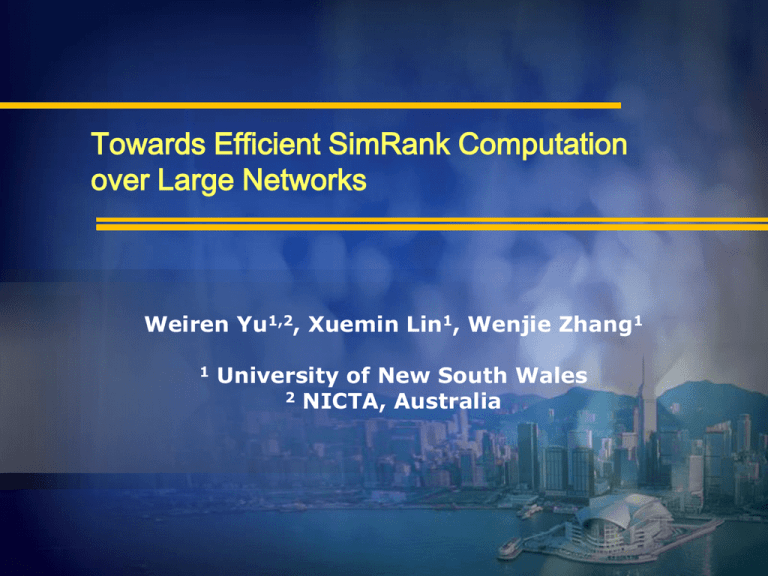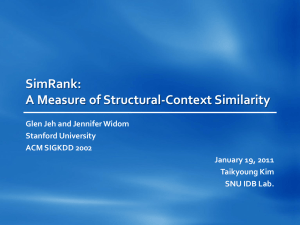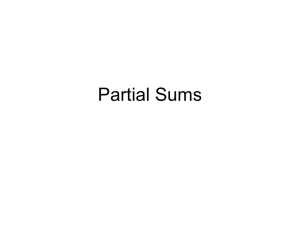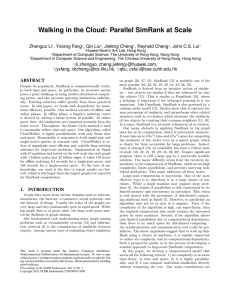icde-2013-yu - University of New South Wales
advertisement

Towards Efficient SimRank Computation
over Large Networks
Weiren Yu1,2, Xuemin Lin1, Wenjie Zhang1
1
University of New South Wales
2 NICTA, Australia
1
Outline
• SimRank overview
• Existing computing method
• Our approaches
• Partial Sums Sharing
• Exponential SimRank
• Empirical evaluations
• Conclusions
2
SimRank Overview
• Similarity Computation plays a vital role in our lives.
Recommender
System
Citation Graph
Collaboration Network
3
SimRank Overview
• SimRank
• An appealing link-based similarity measure (KDD ’02)
• Basic philosophy
Two vertices are similar if they are referenced by similar vertices.
• Two Forms
• Original form (KDD ’02)
damping factor
similarity btw.
nodes a and b
• Matrix form
(EDBT ’10)
in-neighbor set of node b
4
5
Existing Computing Methods
• State-of-the-art Method (VLDB J. ’10)
• Partial Sum Memoization
memoize
reuse
• Two Limitations
• High computation time: O(Kdn2)
• Low convergence rate:
sk ( a , b ) s (a , b ) C
k 1
6
Naïve vs. VLDB J.’10
• Example: Compute s(a,b), s(a,d)
I (a )
b
I (a )
g
b
g
e
e
f
I (b )
g
I (d )
f
i
i
a
Naïve
s k 1 ( a , b )
s k 1 ( a , d )
C
I ( a ) I (b )
C
I (a ) I (d )
s k (i , j )
s k (i , j )
j I ( b ) i I ( a )
j I ( d ) i I ( a )
s k 1 ( a , b )
s k 1 ( a , d )
Duplicate
Computations
7
Naïve vs. VLDB J.’10
• Example: Compute s(a,b), s(a,d)
I (a )
b
g
g
e
s k 1 ( a , b )
I (b )
f
i
Partial Sums Memoization (VLDB J.’10)
a
j,
P artial
sk
I (a)
( j)
s k (i , j )
i I ( a )
s k 1 ( a , b )
s k 1 ( a , d )
C
I ( a ) I (b )
C
I (a ) I (d )
s
Partial I k( a ) ( j )
j I ( b )
j I ( d )
P artial
sk
I (a)
( j)
reuse
I (d )
Partial Sum
Memoization
s k 1 ( a , d )
8
VLDB J.’10 Limitations
• Example: Compute s(a,b), s(a,d), s(c,b), s(c,d)
s
P a rtia l I k( a ) ( g )
I (a )
I (c )
s
b
P a rtia l I k( c ) ( g )
g
g
g
e
e
I (b )
I (d )
i
i
a
s k 1 ( a , d )
s
s k (i , j )
s k 1 ( a , b )
Partial Sums a
Duplicate
Redundancy
j,
s k 1 ( c , d )
P artial I k( c ) ( j )
s
i I ( a )
s k 1 ( a , b )
C
I ( a ) I (b )
j I ( b )
d
f
I (d )
P artial I k( a ) ( j )
g
I (b )
f
j,
b
s k 1 ( c , b )
s k (i , j )
i I ( c )
s
Partial I k( a ) ( j )
s k 1 ( c , b )
C
I ( c ) I (b )
j I ( b )
s
Partial I k( c ) ( j )
Motivation
• Prior Work (VLDB J. ’10)
• High time complexity: O(Kdn2)
• Duplicate computation among partial sums memoization
• Slow (geometric) convergence rate
• Require K = ⌈logCϵ⌉ iterations to guarantee accuracy ϵ
• Our Contributions
• Propose an adaptive clustering strategy
to reduce the time from O(Kdn2) to O(Kd’n2), where d’≤ d.
• Introduce a new notion of SimRank
to accelerate convergence from geometric to exponential rate.
9
Eliminating Partial Sums Redundancy
• Main idea
• share common sub-summations among partial sums
• Example
Existing Approach
sk
P artial I
sk
P artial I
(a)
fine-grained
partial sums
NP-hard to find “best”
partition for I ( a )
(3 additions)
( g ) s k (b , g ) s k ( g , g )
Our Approach
(only 2 additions)
Partition I ( c ) I ( a ) { d }
sk
( g ) s k (b , g ) s k ( g , g ) s k ( d , g )
(c)
P artial I
Duplicate
Computation !!
P artial I
sk
(a)
( g ) sk (b , g ) sk ( g , g )
sk
( g ) P artial I
(c)
(a)
( g ) sk (d , g )
10
Heuristic for Finding Partitions
• Find:
partitions for each in-neighbor set
Minimize: the total cost of all partial sums
• Main Idea
• Calculate transition cost btw. in-neighbor sets
• Construct a weighted digraph
• Find a MST of
s.t.
to minimize the total transition cost
11
12
Example
(4)
(1)
(3)
(2)
13
Example
(1)
+
d
+
b
+
(2)
-
g
f
i
e
a
+
+
+
+
Outer Partial Sums Sharing
• (Inner) partial sums sharing
• Outer partial sums sharing
14
15
Exponential SimRank
• Existing Approach (VLDB J. ’10)
Sk S
For
there are
m ax
C
k 1
Geometric Rate
, to guarantee the accuracy
,
• Our Approach
Sˆ k Sˆ
For
,
m ax
C
k 1
( k 1) !
Exponential Rate
, we need only 7 iterations.
16
Exponential SimRank
Geometric
Sum
• Key Observation
The effect of Ci is to reduce the contribution of long paths relative to short ones
• Main Idea
.
• Accelerate convergence by replacing the geometric sum of SimRank
with the exponential sum.
Differential
Equation
Initial
Condition
Normalized
Factor
Exponential
Sum
SimRank Differential Equation
• Recursive form for Differential SimRank
• Conventional computing method
• Euler iteration: Set
,
• Disadvantage: Hard to determine the value of h.
• Our approach
17
SimRank Differential Equation
• Accuracy Guarantee
• #-Iterations
• Use Lambert W function
• Use Log function (for
• Example (
,
)
)
18
Comparison
• Geometric vs. Exponential SimRank
(Geometric) SimRank
Closed
form
Series
form
Iterative
form
Accuracy
Exponential SimRank
19
Experimental Settings
• Datasets
• Real graph: BERKSTAN, PATENT, DBLP (D02, D05, D08, D11)
• Synthetic data: SYN100K (via GTGraph generator)
• Compared Algorithms
•
•
•
•
OIP-DSR: Differential SimRank + Partial Sums Sharing
OIP-SR: Conventional SimRank + Partial Sums Sharing
psum-SR [VLDB J. ’10]: Without Partial Sums Sharing
mtx-SR [EDBT ’10]: Matrix-based SimRank via SVD
• Evaluations
• Efficiency: CPU time, memory space, convergence rate
• Effectiveness: relative order preservation of OIP-DSR
20
Time Efficiency
21
Space & Convergence Rate
22
Relative Order Preservation
23
Conclusions
• Two efficient methods are proposed to speed up
the computation of SimRank on large graphs.
• A novel clustering approach to eliminate duplicate
computations among the partial summations.
• A differential SimRank model for achieving an
exponential convergence rate.
• Empirical evaluations to show the superiority of
our methods by one order of magnitude.
24
25
Thank you!
Q/A










